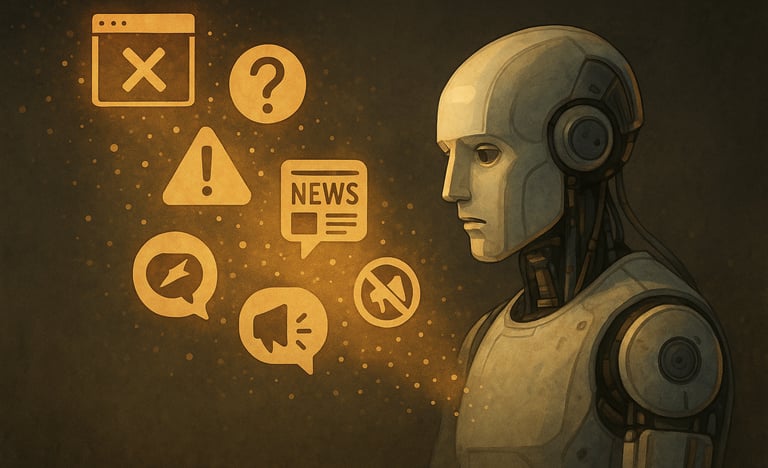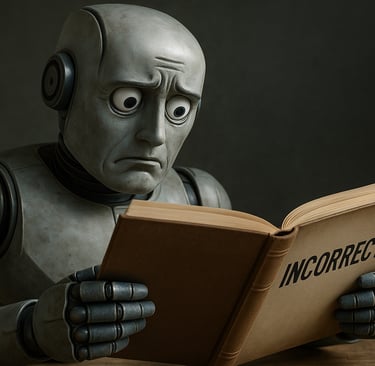Is AI Getting Dumber?
The Great AI Loop: Why Feeding AI Its Own Output May Be Its Downfall
Steve
6/28/20258 min read


Artificial Intelligence has changed the world. It is undebatable. Since 2022, we've seen language models like ChatGPT, Claude, Gemini, and others become everyday tools for writing, coding, analysis, communication, and even therapy. But beneath the awe lies a growing concern—one that few are talking about, yet affects everything from the quality of search results to the future of human knowledge itself:
AI is increasingly learning from AI-generated content—and it’s making AI dumber.
This isn’t a doomsday scenario. But it is a creeping problem with long-term consequences. We are now witnessing a loop where artificial intelligence feeds on content created by other AIs—content that is often shallow, derivative, or flat-out wrong. Left unchecked, this creates a downward spiral in data quality, reducing the effectiveness and reliability of AI itself.
In the golden years of early artificial intelligence development, large language models like OpenAI’s GPT series, Google’s BERT, and others flourished by training on an incredibly diverse and high-quality diet of human-created content. Encyclopedias, books, articles, academic papers, code repositories, and millions of natural conversations formed the backbone of what made AI so powerful. But something shifted after 2022—a subtle yet seismic change that’s only just beginning to make its impact felt.
Today, AI systems are increasingly learning not from human wisdom, but from the output of other AI systems. In this digital loop the snake is beginning to eat its tail. What does this mean for the future of artificial intelligence? More importantly, what does it mean for us, the humans who rely on it?
A New Kind of Training Data — and a New Problem
Before 2022, the majority of online content used to train AI models was written by real people: journalists, authors, scientists, bloggers, and hobbyists. Their unique voices, mistakes, and insights—rooted in lived experience—created a vibrant, if imperfect, tapestry of knowledge. This gave AI something rich to learn from.
But the rise of generative AI tools has drastically changed the content landscape. Today, millions of articles, blog posts, reviews, marketing emails, product descriptions, summaries, and even scientific abstracts are generated by AI. Tools like ChatGPT, Jasper, Claude, and Gemini are producing text at a pace no team of humans ever could. What’s more, a large portion of this content is being indexed and scraped back into the public internet. And guess what? That AI-generated content is now being used to train new AI systems. This means new models are increasingly being fed the output of old ones. The data pipeline is becoming circular. The implications are both fascinating and alarming.
2022: The AI Boom Year
2022 marked a watershed moment. Tools like ChatGPT-3.5 and Stable Diffusion ignited a global surge in generative AI use. Suddenly, anyone could generate articles, essays, code snippets, reviews, ad copy, and even scientific summaries—with just a prompt. Businesses used AI to churn out blog posts. Content farms scaled operations with zero human writers. Students used it for assignments. Marketers used it to automate social media. The result?
An explosion of AI-generated content across every major platform—from Google search results to Amazon product pages to Medium, Reddit, Quora, and beyond. But that’s where the problem began.
The Feedback Loop Begins
AI models like GPT and Claude are trained on massive swathes of internet content. Their performance depends on the quality, diversity, and integrity of that data. Before 2022, most training data came from human-created material: Wikipedia, news archives, books, forums, blogs, and academic papers.
Post-2022, however, AI is increasingly trained on newer data that is itself AI-generated—which is often:
Repetitive (due to pattern-matching algorithms)
Surface-level (lacking depth or insight)
Unverified (lacking real-world grounding)
Optimized for algorithms (not for human learning)
This creates what’s known in AI circles as an “AI echo chamber” or Model Collapse: a cycle where AIs learn from degraded information, produce more of the same, and feed it back into the system.
Central Problem: Quantity Is Outpacing Quality
It’s not that AI content is inherently bad—it can be useful, efficient, even creative. But when AI models can’t tell the difference between genuine knowledge and regurgitated fluff, the system starts to degrade. Here’s an analogy: imagine copying a painting, then making a copy of that copy, and continuing the cycle over and over. Each version gets blurrier, less detailed, and further removed from the original. That’s happening with AI. And it's happening fast.
Key Takeaways: Why This Matters Now
1. Training AI on AI weakens originality
AI-generated content lacks the unpredictability, depth, and nuance of human thought.
Reusing synthetic data can lead to homogenized, formulaic outputs.
2. The “Knowledge Quality” cliff is real
Content created post-2022 is often derivative or even factually incorrect.
The more AI learns from AI, the more errors and hallucinations it may inherit.
3. Pre-2022 human-generated data is gold
It remains the most valuable source of insight, context, creativity, and truth.
Guarding and preserving this corpus is critical to maintaining AI’s usefulness.
4. The risk of “AI inbreeding”
Repeated recycling of low-quality AI content is akin to inbreeding in genetics—decreasing robustness over generations.
5. User trust is at stake
If AI becomes dumber or more repetitive, users will notice—and confidence in the tools will plummet.
Central Problem: Quantity Is Evidence of AI-Content Saturation
Google has acknowledged the rise of “AI spam.” In 2024, they rolled out updates to combat low-quality AI-generated content dominating search results. But that’s just a patch. Meanwhile, open-source researchers have begun creating tools to detect and filter AI-written content before it becomes part of new training datasets. But this is a race against time. And even OpenAI, Anthropic, and Meta are quietly sourcing older, human-created content—such as books, long-form journalism, and academic journals—to compensate for the post-2022 dilution
Why Pre-2022 Content Matters More Than Ever
Before 2022, content was largely written by people. That means:
Errors were human errors (not hallucinated).
Arguments had structure and original thought.
Authors cited sources with intent.
Writing carried voice, tone, and lived experience.
This content holds value not just as knowledge—but as a map of how humans think.
Training AI on pre-2022 material is like giving it a classical education. It can then adapt to modern trends without losing foundational depth. Pre-2022 content is becoming a kind of intellectual fossil record—a snapshot of the world before the rise of synthetic text. Preserving this data, curating it, and ensuring that future models have access to it is crucial. It’s quality control. Projects that aim to archive, protect, or tag human-created content from earlier internet eras may become vital. Not just for historians, but for AI developers who want to avoid building models with cognitive decline.There’s even an argument to be made for “data provenance” systems: labels and watermarks that mark content as human-authored, verified, or synthetic. This would help filter training data and preserve quality.
The Danger of Diminishing Returns
Imagine you’re a student trying to learn calculus. If you learn from the textbook, you get solid, structured information. But if you learn from another student who learned from another student who sort of remembers what the textbook said, the result is a game of knowledge telephone. With each iteration, the signal degrades. That’s exactly what’s happening in AI today.
Every new model trained on data that includes AI-generated text is like a student learning from another student’s notes—not the source material. The quality of understanding drops. The ability to reason, extrapolate, and “think” like a human weakens. We’re seeing models that are better at sounding smart—but not actually being smart. Why? Because AI isn’t reasoning; it’s pattern-matching. When you feed it secondhand patterns, you get thirdhand reasoning.
What's At Stake?
If the trend continues unchecked, we face several critical risks:
Knowledge dilution – Future AI models may offer confident answers that are statistically likely but factually wrong.
Loss of originality – AI outputs will become homogenized and repetitive, with little creative divergence.
Increased misinformation – AI-generated inaccuracies could be reinforced, repeated, and accepted as truth.
Erosion of trust – Users will lose faith in AI tools as outputs become less reliable or useful.
Ironically, the smarter AI gets, the more it needs to be reminded what real intelligence looks like.


Can This Be Fixed?
There are several possible strategies:
Data Auditing: Actively filtering out AI-generated content from training sets.
Provenance Tracking: Using metadata to determine the source and nature of content (e.g., human vs AI).
Hybrid Models: Combining neural nets with logic-based reasoning or verified databases.
Open Human Archives: Building new datasets composed entirely of human-made content, especially pre-2022 material.
AI Literacy: Educating users on how to spot low-quality content—and demand better.
None of these are easy, but they are essential.
The Bigger Question: Should We Slow Down?
There’s a broader philosophical dilemma emerging: in our rush to scale AI, are we forgetting to sustain it? Bigger isn’t always better. Faster isn’t always wiser. If every new model is trained faster, cheaper, and with less human oversight—mostly on the outputs of older models—then we are building a future of increasingly hollow intelligence. The human mind evolved over millions of years, learning from nature, peers, pain, beauty, and experience. AI is learning from product descriptions and Reddit threads. And now... itself.
If we want AI that understands us, it must be rooted in our thoughts—not regurgitated digital soup.
Final Thoughts
We stand at a crossroads in AI history. The post-2022 boom in generative tools has unlocked incredible productivity—but also seeded a dangerous feedback loop. If left unchecked, AI systems will continue to learn from each other, reinforcing errors, flattening creativity, and slowly drifting away from the rich complexity of human language, knowledge, and culture.
To stop the “dumbing down” of AI, we must:
Preserve pre-2022 data like the precious cultural artifact it is.
Demand transparency in training sources.
Resist the urge to prioritize scale over substance.
Recommit to the idea that AI should serve human understanding—not imitate itself endlessly.
Because in the end, artificial intelligence is only as smart as the data it’s given.
And if we feed it digital leftovers, we shouldn’t be surprised when it forgets the recipe for brilliance.
Data Homogenization: A Silent Killer
AI-generated content tends to be predictable. It uses statistically safe phrasing. It avoids controversy. It often defaults to a middle-of-the-road tone and structure. When models are retrained on this kind of content, their future output becomes even more bland, repetitive, and stale. We start to lose originality. The wide variance that made pre-2022 internet content so informative and surprising disappears. This is already becoming noticeable. Users report that some models are becoming “samey.” The jokes are more generic. The blog posts sound templated. Creative writing prompts get duller responses.
In short, AI is slowly becoming a copy of a copy of a copy.
Garbage In, Garbage Out: Now at Scale
One of the founding truths in computing is “GIGO”—garbage in, garbage out. If you feed a machine poor-quality input, you’ll get poor-quality results. When AI was trained on Reddit threads, scholarly articles, and classic literature, the quality of output was generally high (assuming proper filtering and alignment).
But what happens when AI is trained on spammy, keyword-stuffed, AI-written articles that were designed to trick SEO algorithms, not help humans? You get... garbage. At scale.
Hallucination and Misinformation: Now with a Feedback Loop
AI hallucinations—false information confidently stated as fact—have always been a problem. But now those hallucinations are appearing in published content online. That content is then scraped, indexed, and used to train other models. It’s the AI equivalent of quoting a liar who’s quoting another liar who misread the first one. Over time, this creates a misinformation loop. And because it’s dressed up in fluent language, it’s easy to miss. We’re entering an era where AI can quote itself and no one will know it’s wrong.
This cycle is dangerous because AI doesn’t know it’s reading low-quality content. It processes it the same way it would process a Pulitzer-winning essay or a NASA whitepaper. Worse, the more AI-generated content pollutes the web, the harder it becomes to find fresh, authentic human perspectives. And that's exactly why this blog post was researched and formulated by AI but ultimately fact-checked and rewritten then given my own additions and input.
The Loss of Rare Knowledge
Another looming danger is the loss of rare knowledge—details that exist in niche forums, deep books, obscure articles, or firsthand human experience. These sources are being drowned out by mass-produced AI content. And because AI prefers what’s popular (statistically significant), rare but important knowledge is increasingly underrepresented in model outputs. This is especially dangerous in fields like history, science, or law—where details matter, and consensus isn’t always correct. The internet was once a messy treasure chest. AI is slowly turning it into a well-swept library where only the middle shelves are stocked.
Contact
e: info@onlineun.ltd
Socials
Subscribe to our newsletter
t:+447481019843
